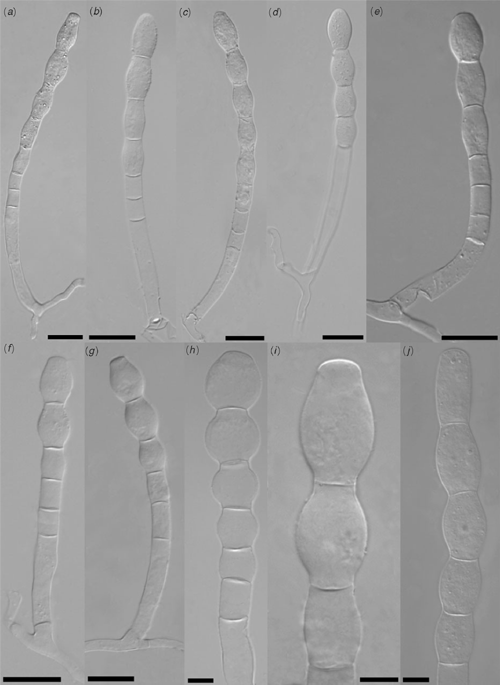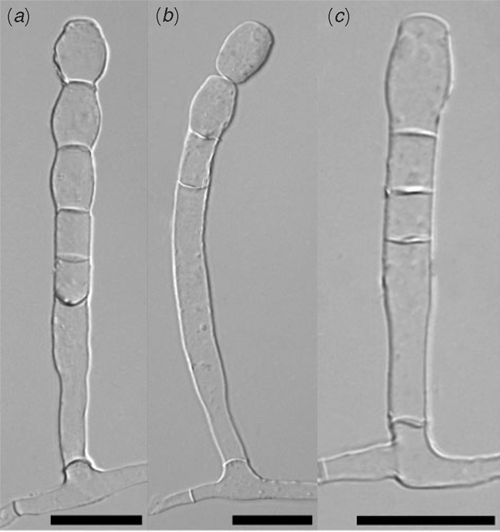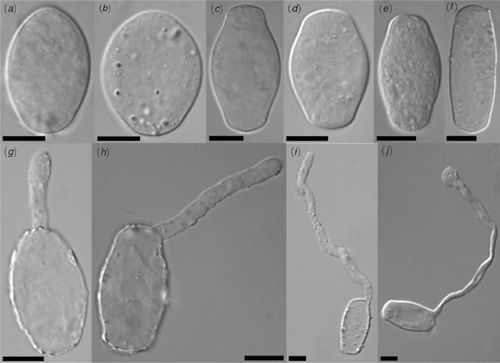Powdery mildew on Mentha in Australia
J. R. Liberato A C and J. H. Cunnington BA Department of Primary Industries and Fisheries, Plant Pathology Herbarium, 80 Meiers Road, Indooroopilly, Qld 4068, Australia.
B Primary Industries Research Victoria, Department of Primary Industries, Knoxfield, Private Bag 15, Ferntree Gully Delivery Centre, Vic. 3156, Australia.
C Corresponding author. Email: jose.liberato@dpi.qld.gov.au
Australasian Plant Disease Notes 2(1) 83-86 https://doi.org/10.1071/DN07034
Submitted: 4 May 2007 Accepted: 10 May 2007 Published: 25 May 2007
Abstract
The Australian specimens of powdery mildew on Mentha held in the Australian National Collection of fungi were examined. The only species observed was the anamorph of Golovinomyces biocellatus. A detailed description and illustrations of the specimens are given, along with the rDNA internal transcribed spacer sequence of one of the specimens.
Mentha (Lamiaceae) is a group of well-known, aromatic, perennial herbs, long and widely cultivated throughout the world. They are a source of menthol and essential oils used in confectionery and liqueurs, in pharmaceutical and dental preparations, and to flavour foods (Purseglove 1968).
As part of an ongoing review of the Australian powdery mildew fungi, 11 out of 13 specimens of powdery mildew collected on Mentha and held in the Australian National Collection of Fungi were examined. Morphology of the fungi was examined on microscopic mounts in lactic acid. Biometric data were obtained only from the examination of turgid structures and only mature conidia (those unattached to conidiophores) were measured. The specimen VPRI 19144 was in poor condition and it was not possible to identify it. All other specimens were identified as Golovinomyces biocellatus and their description is given below.
Golovinomyces biocellatus (Ehrenb.) V.P. Gelyuta, Ukr. bot. Zh. 45(5): 62 (1988) on Mentha spp. (Figs 1–3)

|

|

|
Mycelium amphigenous, mainly on the upper leaf surface. Also present on stems. Superficial hyphae branched, septate, hyaline, substraight to flexuous, 4–7.5 μm wide, mycelial appressoria indistinct. Conidiophores produced from the external mycelium, hyaline, smooth, septate, foot-cells usually straight, 20–124 × 10–15 μm, sometimes 4–6 μm narrower towards the base (one fifth to three fifth of foot-cell is narrower), followed by (0–)1–3(–5) shorter cells. Conidia produced at the apex of the conidiophores, up to six immature conidia in a chain with sinuate edge, hyaline, smooth, lacking fibrosin bodies. The first conidium produced is ovoid with a rounded apex and a flattened base, the following conidia are mostly doliform (barrel-shaped) and rarely subcylindric. Mature conidia measure 22.5–42.5 × 15–25 μm, l/w ratio 1.4–2.3. One or two germ tubes on the shoulder of the conidium, up to 2× (–5×) the length of the conidium, usually with indistinct appressorium, sometimes apically club-shaped. Teleomorph not found.
Distribution in Australia: Qld, Tas, Vic.
Material examined
Mentha sp.: Qld: Chapel Hill, Brisbane, 10 Jul 2005, J.L. Alcorn (BRIP 46650 = VPRI 32381); Kenmore, Brisbane, 12 Jun 1984, V.H. Boughton (BRIP 14344); Mareeba, 5 Dec 2006, K. Grice (BRIP 48830); Tas: Devonport, 09 Mar 1994, B. Beattie (VPRI 19885); Vic.: Baxter, 12 Dec 1992, P. Maher (VPRI 18618).
Mentha australis R. Br.: Vic.: Brisbane Ranges National Park, 06 Mar 1993, T.W. May (VPRI 18893); Unknown place (Australia): 04 Feb 1998, F. Cooper (VPRI 21679).
Mentha suaveolens Ehrh.: Qld: Mt Coot-tha, Brisbane, 02 Aug 1994, A. Sivapalan (VPRI 20329).
Mentha × gentilis sp.: Vic.: Melbourne, 11 Aug 1994, coll. unknown (VPRI 20318).
Mentha spicata L.: Vic.: Maldon, 30 Jan 1993, A. Sivapalan (VPRI 18758).
Only one fresh specimen was examined (BRIP 46650) and it lacked fibrosin bodies. A rDNA internal transcribed spacer (ITS) sequence was obtained from this specimen, according to Cunnington et al. (2003). The sequence differed by two bases from the Australian G. biocellatus sequence (VPRI 19250 on Mentha sp.) obtained by Cunnington et al. (2003). But, it was between zero and two bases different from three other G. biocellatus sequences on GenBank. The sequence obtained here has been lodged on GenBank.
The lists of plant diseases in Australia (Simmonds 1966; Pitkethley 1970; Chambers 1982; Sampson and Walker 1982; Cook and Dube 1989; Shivas 1989) do not report any powdery mildew on Mentha. The only mentions of the occurrence of G. biocellatus on Mentha in Australia are in Cunnington (2003) and Cunnington et al. (2003). According to Braun (1987, 1995), Golovinomyces biocellatus is widespread on numerous host species of various host genera of the Lamiaceae in Europe, Asia, North America and North Africa and also occurs in South America and South Africa.
According to Braun (1987), five species of powdery mildew belonging to the subfamily Erysiphoideae (anamorph Oidium), which have euoidium-type conidiophores (conidia produced in chains) can infect plants belonging to Lamiaceae: Golovinomyces biocellatus (≡ Erysiphe biocellata Ehrenb.), Neoerysiphe galeopsidis (DC.) U. Braun (≡ Erysiphe galeopsidis DC.), Oidium ocimi S. Naray. & K. Ramakr., Oidium violae Pass. (anamorph of Golovinomyces orontii (Castagne) V.P. Gelyuta (≡ Erysiphe orontii Castagne)) and Podosphaera fusca (Fr.) U. Braun & N. Shishkoff s. lat. ( = Sphaerotheca fusca (Fr.) Blumer emend. U. Braun). Erysiphe rabdosiae R.Y. Zheng & G.Q. Chen was also described on Lamiaceae, however, its anamorph was poorly described (Zheng & Chen 1981), so its taxonomic status is unclear.
Golovinomyces biocellatus differs to N. galeopsidis as the latter has smaller foot-cells (25–50 μm long) and moderately lobed mycelial appressoria (Braun 1987). Oidium ocimi is insufficiently known and, according to Braun (1987) maybe it belongs to G. biocellatus or N. galeopsidis. Unlike G. biocellatus, G. orontii has nipple-shaped mycelial appressoria, foot-cell often curved in the basal half, germ tube usually fairly short, about as long as the conidium or shorter, frequently somewhat twisted, broadened, sometimes straight, bent or helicoid, rarely forked, apically often somewhat swollen (Braun 1987). Podosphaera fusca s. lat. is easily distinguished from G. biocellatus as the former has conidia containing fibrosin bodies, germ tube swollen or forked, crenate edge of the immature conidia in chain and intercalary mature conidia (Braun 1987).
Braun U
(1987) A monograph of the Erysiphales (powdery mildews). Beih. Nova Hedwigia 89, 1–700.

Cunnington JH,
Takamatsu S,
Lawrie AC, Pascoe IG
(2003) Molecular identification of anamorphic powdery mildews (Erysiphales). Australasian Plant Pathology 32, 421–428.
| Crossref | GoogleScholarGoogle Scholar |

Shivas RG
(1989) Fungal and bacterial diseases of plants in Western Australia. Journal of the Royal Society of Western Australia 72, 1–62.

Zheng RY, Chen GQ
(1981) The genus Erysiphe in China. Sydowia 34, 214–327.



